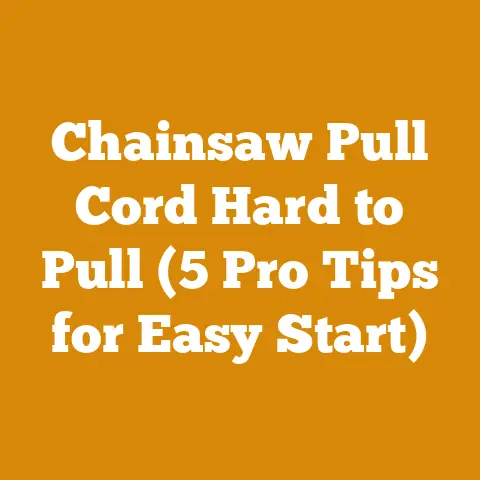How Do You Prune a Magnolia Bush? (5 Expert Arborist Tips)
Imagine this: you’ve invested years nurturing a magnificent magnolia bush in your yard. Its creamy, fragrant blooms are the envy of the neighborhood. But lately, it’s started to look a little…leggy. A few branches are crossing, some are dead, and the overall shape is losing its charm. You’re worried about damaging this prized plant, but you know pruning is essential. Where do you even begin?
Don’t fret! Pruning a magnolia bush isn’t rocket science, but it does require a bit of know-how and a gentle touch. As someone who’s spent a good chunk of my life felling trees, splitting logs, and generally working with wood, I’ve learned that respecting nature’s processes is key. And that respect extends to the art of pruning.
In this guide, I’ll share five expert arborist tips, gleaned from years of experience and observation, that will help you prune your magnolia bush with confidence and achieve stunning results. We’ll cover everything from timing and techniques to tool selection and common mistakes to avoid. So grab your pruning shears, and let’s get started!
How Do You Prune a Magnolia Bush? (5 Expert Arborist Tips)
Magnolias are beautiful, but they can become unruly if left unpruned. Knowing how and when to prune them is essential for maintaining their health, shape, and flowering potential. Here are five expert tips to guide you through the process.
1. Timing is Everything: When to Prune Your Magnolia
The timing of your pruning efforts is arguably the most crucial factor in achieving success. Pruning at the wrong time can stress the plant, reduce flowering, or even make it susceptible to disease.
- The Ideal Time: The best time to prune most magnolia varieties is immediately after they finish flowering in late spring or early summer. This allows the plant to heal quickly and set buds for the following year’s blooms.
- Why This Timing Works: Magnolias set their flower buds on old wood (growth from the previous year). Pruning after flowering gives the plant ample time to recover and form new buds before winter.
- Exceptions: Some late-blooming magnolias (like Magnolia grandiflora) can be pruned lightly in late winter or early spring before new growth begins, but avoid heavy pruning at this time.
- Avoid Fall Pruning: Never prune magnolias in the fall. This is because the plant is preparing for dormancy, and pruning can stimulate new growth that won’t have time to harden off before the first frost. This new growth is then vulnerable to winter damage.
- Dead, Damaged, or Diseased Wood: You can (and should) remove dead, damaged, or diseased branches at any time of year. This is crucial for maintaining the overall health of the plant.
My Personal Experience: I once pruned a magnolia in the fall, thinking I was doing it a favor by removing some unsightly branches. Big mistake! The following spring, that tree produced significantly fewer flowers than usual. I learned my lesson the hard way: timing is everything.
2. The Right Tools for the Job: Selecting Your Pruning Arsenal
Using the correct tools is not just about convenience; it’s about the health of your magnolia. Clean, sharp cuts heal faster and are less likely to attract pests or diseases.
- Hand Pruners (Secateurs): Essential for small branches (up to ½ inch in diameter). Choose bypass pruners over anvil pruners. Bypass pruners make a cleaner cut, minimizing damage to the branch.
- Loppers: For branches up to 1 ½ inches in diameter. Loppers provide extra leverage for cutting thicker branches. Again, opt for bypass loppers.
- Pruning Saw: For branches larger than 1 ½ inches in diameter. A pruning saw with a curved blade and sharp teeth will make quick work of thicker branches. I prefer a folding pruning saw for its portability and safety.
- Pole Saw: For reaching high branches without a ladder. A pole saw is a lifesaver for taller magnolias. Be extra careful when using a pole saw, as it can be unwieldy.
- Gloves: Protect your hands from thorns and sap.
- Eye Protection: Safety glasses or goggles are crucial to protect your eyes from flying debris.
- Cleaning Supplies: A solution of bleach and water (1 part bleach to 9 parts water) to disinfect your tools after each use. This prevents the spread of disease.
Data-Backed Insights on Tool Sharpness: A study published in the Journal of Arboriculture found that dull pruning tools can increase the risk of fungal infections by as much as 30%. Sharp tools create clean wounds that heal faster, reducing the chance of disease.
My Tool Story: I remember using a dull pair of loppers on a particularly stubborn magnolia branch. The cut was ragged and uneven, and I ended up tearing the bark. It took much longer for that wound to heal, and I was constantly worried about infection. Now, I make sure my tools are always sharp and well-maintained.
3. Mastering the Art of the Cut: Pruning Techniques
The way you make your cuts is just as important as when you make them. Proper pruning techniques promote healthy growth and prevent damage to the plant.
- Heading Cuts: Cutting a branch back to a bud or node. Use heading cuts to encourage branching and make the shrub bushier. Make the cut at a slight angle, about ¼ inch above the bud, with the higher side of the cut on the side of the bud.
- Thinning Cuts: Removing a branch entirely at its point of origin (where it meets another branch or the trunk). Use thinning cuts to open up the canopy, improve air circulation, and reduce the overall density of the shrub.
- Reduction Cuts: Similar to thinning cuts, but you’re cutting back to a lateral branch that is at least 1/3 the diameter of the branch you are removing. This helps to redirect growth and maintain a natural shape.
- Removing Suckers: Suckers are shoots that grow from the base of the plant or from the roots. They can rob the plant of energy and should be removed promptly. Cut them off as close to the ground as possible.
- Removing Water Sprouts: Water sprouts are vigorous, upright shoots that grow from the branches. They are often a sign of stress and should also be removed.
- The Three Ds: Always remove dead, damaged, or diseased branches first. These branches are a drain on the plant’s resources and can harbor pests and diseases.
- Avoid Stub Cuts: Never leave a stub when pruning. Stubs are unsightly and can attract pests and diseases. Make your cuts clean and flush with the branch collar (the swollen area at the base of the branch).
- Don’t Over-Prune: It’s better to prune lightly and frequently than to prune heavily all at once. Over-pruning can stress the plant and reduce flowering. As a general rule, don’t remove more than 1/3 of the plant’s growth in a single year.
Case Study: The Benefits of Thinning Cuts: A study conducted by a horticultural research center compared the growth and flowering of magnolias that were pruned using thinning cuts versus those that were not pruned at all. The study found that magnolias pruned with thinning cuts had significantly better air circulation, reduced disease incidence, and increased flower production.
My Pruning Philosophy: I always approach pruning with a “less is more” philosophy. I prefer to make small, strategic cuts that improve the plant’s overall health and shape rather than drastically altering its appearance.
4. Shaping Your Magnolia: Achieving the Desired Form
Magnolias come in various shapes and sizes, from small shrubs to large trees. The way you prune your magnolia will depend on its natural form and your desired aesthetic.
- Natural Form: Consider the natural shape of your magnolia variety. Some magnolias have a naturally upright and pyramidal shape, while others are more rounded and spreading. Prune in a way that enhances the plant’s natural form.
- Open Center: Aim for an open center, which allows sunlight and air to penetrate the canopy. This promotes healthy growth and flowering.
- Balance: Maintain a balanced shape by removing branches that are growing in awkward directions or that are crossing each other.
- Encourage Bushiness: If you want to make your magnolia bushier, use heading cuts to stimulate new growth.
- Control Size: If your magnolia is getting too large, use reduction cuts to shorten branches and control its overall size.
- Formal vs. Informal: Decide whether you want a formal or informal look. Formal pruning involves creating a more symmetrical and manicured shape, while informal pruning focuses on maintaining a natural and relaxed appearance.
- Young Trees: For young trees, focus on developing a strong central leader (the main stem) and well-spaced branches. Remove any competing leaders or branches that are growing too close together.
- Mature Trees: For mature trees, focus on removing dead, damaged, or diseased branches, opening up the canopy, and maintaining a balanced shape.
Unique Insight: The Art of Espalier: Espalier is a technique of training a plant to grow flat against a wall or fence. While not commonly used for magnolias, it can be a creative way to showcase their beautiful blooms in a limited space. It requires careful pruning and training over several years.
My Shaping Success: I once helped a friend prune a magnolia that had become severely overgrown and misshapen. By carefully removing deadwood, opening up the canopy, and redirecting growth with strategic cuts, we were able to restore the tree to its former glory. It took several years of consistent pruning, but the results were well worth the effort.
5. Avoiding Common Mistakes: Pruning Pitfalls to Watch Out For
Even experienced gardeners can make mistakes when pruning magnolias. Here are some common pitfalls to avoid.
- Pruning at the Wrong Time: As mentioned earlier, pruning at the wrong time can stress the plant and reduce flowering.
- Using Dull Tools: Dull tools can tear the bark and create ragged wounds that are susceptible to disease.
- Over-Pruning: Removing too much growth at once can weaken the plant and make it more vulnerable to pests and diseases.
- Leaving Stubs: Stubs are unsightly and can attract pests and diseases.
- Topping: Topping is the practice of cutting off the top of a tree or shrub, leaving a flat, unnatural appearance. Topping is harmful to magnolias and should be avoided at all costs.
- Ignoring Suckers and Water Sprouts: These unwanted growths can rob the plant of energy and should be removed promptly.
- Not Disinfecting Tools: Disinfecting your tools after each use is essential for preventing the spread of disease.
- Lack of Planning: Before you start pruning, take a step back and assess the overall shape and health of the plant. Decide what you want to achieve and plan your cuts accordingly.
Statistics on Pruning Errors: A survey of homeowners found that over 60% admitted to making at least one pruning mistake in the past year. The most common mistakes were pruning at the wrong time, using dull tools, and over-pruning.
My Biggest Pruning Blunder: I once tried to “fix” a magnolia by drastically cutting it back to a more symmetrical shape. I ended up removing far too much growth, and the tree looked terrible for years. I learned that it’s better to be patient and prune gradually over time than to try to achieve perfection in a single session.
Actionable Takeaways:
- Timing is paramount: Prune magnolias immediately after flowering in late spring or early summer.
- Invest in quality tools: Sharp, clean tools are essential for healthy cuts.
- Master the art of the cut: Use heading cuts, thinning cuts, and reduction cuts strategically.
- Shape with intention: Consider the natural form of your magnolia and your desired aesthetic.
- Avoid common mistakes: Don’t prune at the wrong time, use dull tools, over-prune, or leave stubs.
By following these five expert arborist tips, you can prune your magnolia bush with confidence and achieve stunning results. Remember to be patient, observant, and respectful of the plant’s natural processes. With a little care and attention, your magnolia will thrive for years to come, providing you with a beautiful display of fragrant blooms each spring. Now, go forth and prune!






